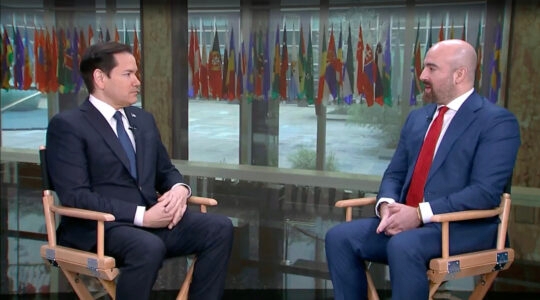LOS ANGELES (JTA) – In a knowledge world ruled by books and pages and digitized memory, why do Jews hold onto the scroll?
As Shavuot and its focus on receiving the Torah approach, I must ask: Could it be that rolled along together somewhere in our minds with the love of Torah is the love of scroll?
We are fascinated with book forms that when opened, extended, unfolded or unrolled change shape before our eyes. In the scroll, we have a form that can also expand our minds.
Though the scroll is used in other cultures and religions, it remains a distinctive Jewish form, distinguishing it especially from early Christian writings that used the newer form – the Roman codex, or book, to record their writings. It is our handmade, not mass-produced form passed from generation to generation that we read, study and honor.
Seeing the words of the Torah scribed in perfect columns makes us think of a book. But as the parchment unrolls without a beginning or an end in sight, we think of a journey. You find your place in a book by turning the pages, moving through paper by the numbers. With the Torah, you turn and turn and move through place and time.
Grab on to the wooden spindles to which the Torah is attached, the etzai chaim. As your hands and arms move, you also move through time, places, names and law. As you cross the Red Sea, you cross the sea of context as well. As you scroll, and the portion is chanted, the physical action moves you inside the story: the sea parts, you hurry through, and are saved and ready to sing as you reach the other side.
Consider that in the Torah when the Ten Commandments are given, they are written on two tablets. From a book designer’s point of view, the tablets are two pages – a spread. Form-wise this is perfect – attention is focused only on the two tablets; nothing more is needed.
Yet the Torah is not contained on a series of tablets or pages, it is on a roll. So where is our attention directed?
Open the Torah scroll to a single column and that is what we see. Open it two columns, three, four, and our attention suddenly opens to the entire beautiful calligraphic panorama before us.
As time passes the scroll becomes more modern. As an information system, the scroll is a forerunner to many of our modern information systems that also work by revolving mechanisms: computer hard drives and DVD players. We scroll down our computers only reluctantly, hoping what we need is in the opening screen. But unlike the monitor, the Torah scroll encourages us by its form to scroll across – to continue to read, visualize and, week after week, make the journey’s end.
Our brains are wired mostly for visual experience. It‘s a visual system that is ready for more. As you scroll through the Torah, names and places pass by and the mind makes connections. The scroll encourages the particular form of Jewish study that requires skipping from passage to passage, and from book to book. (So, add Web surfing to the claims of Jewish invention). The form helps the mind hold together as one the words, the verses and parashot from throughout the Torah.
For those whose task it is to the find the place in the Torah for their congregations, the scroll can be a curvilinear calendar, the position of the reading being associated with season or date. Many of us know that if the left side is small, then the end of the Jewish year is approaching and it is time to send out your Rosh HaShanah cards.
Even our coming Shavuot readings remind us of the scroll’s circularity. On this holiday, many read the liturgical poem Akdamut, which pays poetic homage to the endlessness of Torah. The end of each line ends with the Hebrew letters tav-alef, the final and first letters of the Hebrew alphabet, reminding us that when we get to the end of the scroll we begin anew.
Our culture places high value on creating whole designed environments. In restaurants, hotels, theaters and homes, we surround ourselves with music, lighting, art and colors. We admire the seamless and the artful motif.
The scroll, the Torah, is a gateway to a whole environment as well. It unrolls in so many ways, and as it does, we can become enveloped by its words and texture, and understand that indeed everything is in it.
It is said that on the first night of Shavuot, at midnight, the heavens open. This year, imagine they unroll.
(Edmon J. Rodman, a book and toy designer, designed “Mitkadem” and “Jewish Holidays Building Blocks.” He is the author of “Nomo, the Tornado Who Took America By Storm.” He is a Torah reader and occasional roller at the Movable Minyan in Los Angeles.)
JTA has documented Jewish history in real-time for over a century. Keep our journalism strong by joining us in supporting independent, award-winning reporting.





